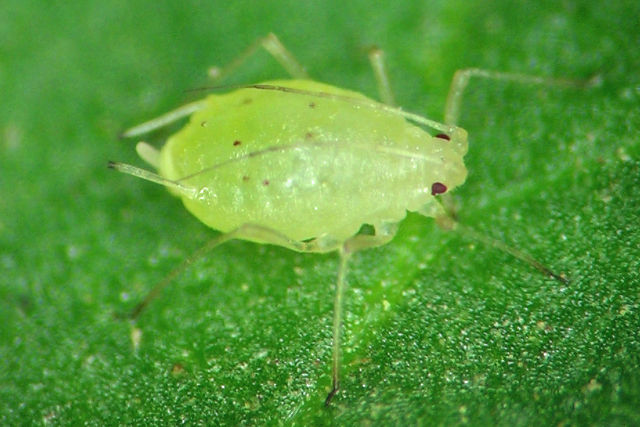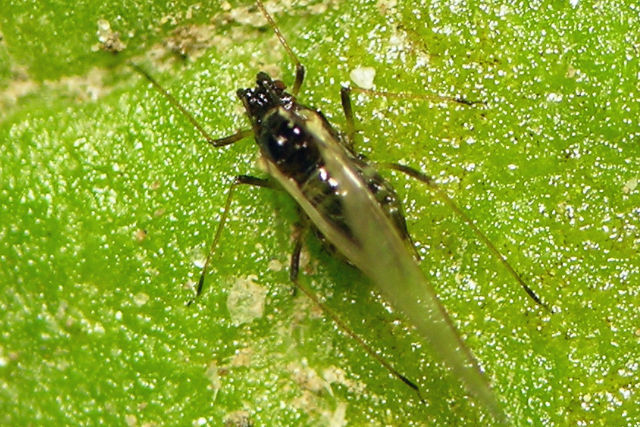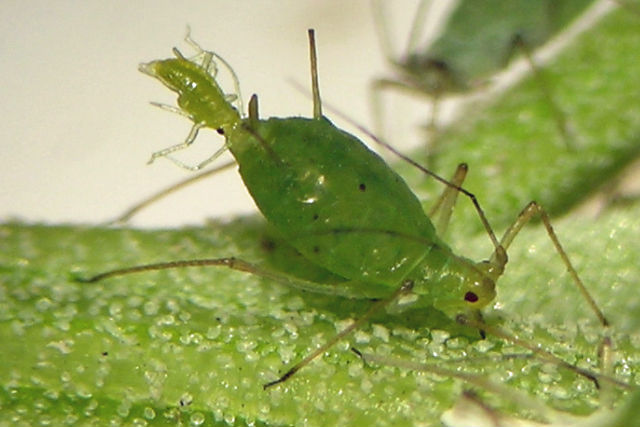Tiny Aphids Can Wreak Big Havoc in Potato Fields
May 8, 2022




Relevant: 75-Day IPM Potato Program
Aphids are notorious for spreading viruses that can wreak havoc on entire fields of commercial and seed potatoes.
Yet it’s their unique weirdness that farmers should familiarize themselves with to help avoid a financial wreck.
During much of the potato growing season, females produce genetically identical offspring of themselves, and all offspring are female. These females, in turn, are born live and pregnant.
“All this strangeness means that aphids can reproduce and populate very quickly,” says entomologist Andy Jensen, manager of the Northwest Potato Research Consortium, which oversees research funding for the Idaho, Oregon and Washington potato commissions.
Some aphids colonize and reproduce in potato fields; others just give the plants a taste and then move on. Also varying widely is the way the insects transmit destructive viruses, notably Potato virus Y (PVY) and Potato leaf roll virus (PLRV).
Many species can transmit PVY, but only two commonly colonize potato fields in most North American growing regions—the potato aphid and the green peach aphid, the latter of which is very efficient at transmitting viruses, points out Andrei Alyokhin, University of Maine professor of applied entomology.
Aphids 101
Identification and Lifecycle
Like dozens of other aphid species, both the potato and green peach aphid occur in a range of colors, can be winged or wingless and have varying lifecycles. Farmers are encouraged to work with local experts and glean information from reputable sources (links in this article will take you to several websites offering valuable information).
Crop Damage
Aphids can significantly reduce yield and cause serious defects in tubers, mostly through the spread of PVY and PLRV.
Erik Wenninger, University of Idaho associate professor of entomology, says that there are more than 50 aphid species that can transmit PVY to potatoes. Fortunately, the vast majority aren’t crazy about dining in potato fields.
But there’s an unfortunate caveat.
“Insects in general—aphids included—are not necessarily all that good at finding their host plant. So they see something green that smells like their host plant, and they drop down to give it a taste test,” Wenninger says. “If it turns out to be something they don’t want—like a potato plant—they’ll fly off and look for another plant.”
The aphids disappear as quickly as they arrived, but those carrying PVY can leave behind a path of ruin.
Scouting
When potatoes emerge, fields should be checked for aphids at least once per week, more often if possible. Since non-colonizing aphids are generally impossible to spot using visual observations of potato foliage, they should be monitored using yellow traps, such as water pans or sticky cards.
“You or your consultant must know how to recognize aphids from each other and aphids from other insects to carry out a successful management plan,” Jensen stresses.
Best Management Practices for Controlling Aphids
Farmers can take many proactive steps to safeguard their potato fields, including the following:
- Plant certified disease-free seed. Wenninger emphasizes: “PVY is becoming an increasingly serious problem, so start your BMP program by not planting a problem in the first place.”
- Plant borders around seed potato fields, and work with local consultants to select plants that won’t be harmed by PVY-depositing aphids.
- Keep weeds at bay (particularly nightshade, which is in the same family as potatoes), and consider adding flowering plants to borders since many beneficial insects prey heavily on aphids.
- Control volunteer potatoes in non-potato crops, isolate seed lots from other potato production and spray crop oils on a regular basis, advises Alyokhin.
- Judiciously choose and apply pesticides since aphids are quite vulnerable to biological control agents like ladybugs.
Wenninger says that at-plant neonicotinoids work well against aphids for approximately 60 to 90 days. Once they start wearing off, other classes of systemic foliar insecticides that move through plant tissue effectively control green peach and potato aphids.
Controlling non-colonizing aphids is a different story because PVY is transmitted so quickly.
That’s why it is important for growers to carry out an integrated pest management plan on their entire farm and to work with neighbors in tackling aphids.
“It might be economical to consider paying for aphid control in your neighbor’s barley or wheat field to limit the spread of virus in your potatoes,” Wenninger notes.
And when it comes to potato fields, he urges farmers to rotate different chemical classes for best results.
“Systemic insecticides target insects that are feeding on plants themselves, so they have little or no effect on beneficial insects. This applies especially to potato fields versus some other crops that produce flowers heavily visited by beneficial insects seeking nectar or pollen,” adds Wenninger, who notes that Bayer’s Admire® Pro is among the effective at-plant insecticides.
Turning to foliar insecticides, he says, “Many fail to provide good aphid control because they don’t work systemically; however, there are several effective products that do move through the plant tissue.”
Among those he mentions are Movento® and Sivanto® Prime, additional pest control solutions from Bayer.
Bayer Solutions
Admire Pro is typically used as an in-furrow, at-plant insecticide. It is then taken up by the roots of the potato plant and provides good protection against aphids for 60 to 90 days.
Once it starts wearing off, commercial and seed growers—including those growing certified seed potatoes—can rely on the foliar insecticides Movento and Sivanto Prime.
“Movento controls a number of potato pests, aphids being one of great concern because they vector PVY and PLRV,” says Monte Sorensen, Bayer product manager for insecticides. “Since Movento is a systemic, it will help protect newer growth, and it also provides good residual control, up to three to four weeks.”
And, if growers want to stop damage quickly, Sivanto Prime can successfully be worked into an aphid control program.
“Sivanto has fast feeding cessation, meaning it quickly stops their feeding activity,” Sorensen says. “And the sooner you can stop aphids from feeding, the less likely they’ll be able to transmit viruses.”
For more information about aphid control options as well as other potato pests, including nematodes and psyllids, refer to resources on Bayer’s 75-Day IPM Program for potatoes so you can create an agronomic force field. Always read and follow label instructions.